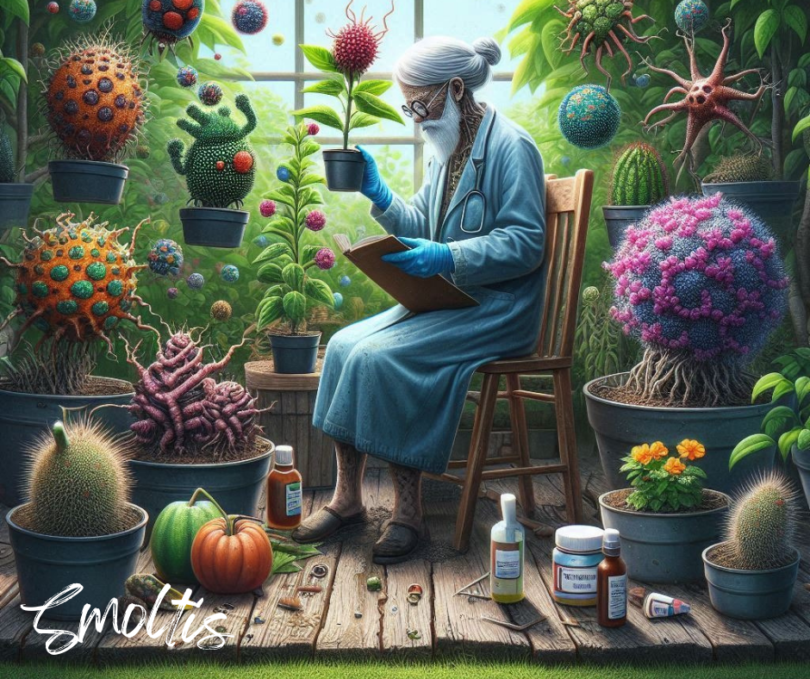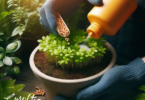Keeping plants healthy can be tough, especially with diseases lurking. But by using smart strategies before and during planting, you can fight off these threats. This is true even in shady spots.
A cluster of withered leaves and drooping stems in a dimly lit and damp environment, surrounded by small patches of mold or fungus growth.
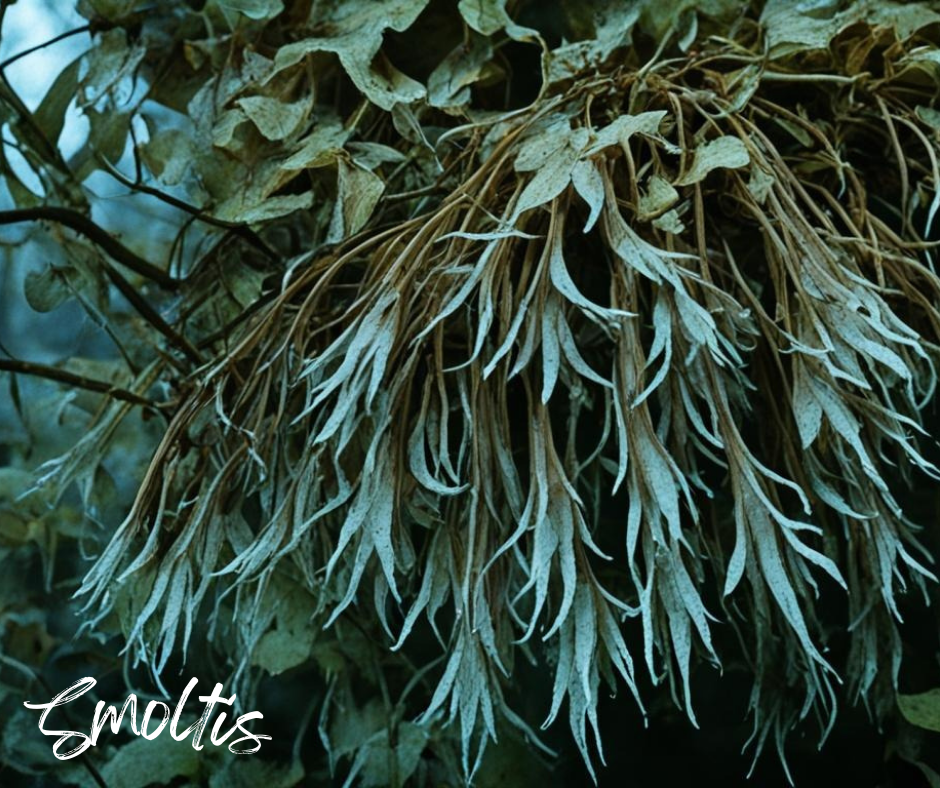
It all starts with picking the right place and plants.1 To figure out what a plant needs, you should know about its type, where it is, and the usual issues it faces. Simply put, a plant disease is when a problem is caused by something harmful. What’s tricky is figuring out if the issue is because of a disease or something else. This step is key to stopping the problem in its tracks.
Key Takeaways
- Starting with the right site and plants is the first step against diseases.
- Knowing the plant, its home, and common diseases helps with diagnosis.
- Distinguishing between true diseases and other problems is vital for control.
- In cold places, pathogens have to survive without their usual hosts in winter.
- External issues, like bad weather or harmful chemicals, can make plants more vulnerable to diseases.
Understanding Plant Diseases
Disease as a Plant’s Response
A plant disease happens when a plant is constantly bothered by something harmful. This can be a pathogen, an infectious agent.2 Such diseases may stop the plant from growing, reproducing, or doing well.
Biotic vs. Abiotic Disorders
It’s hard to tell some plant diseases apart. It’s very important to know if the problem is from a living thing (biotic) or not (abiotic). The things that cause plant diseases are live and are called pathogens. Others are due to nonliving things. Spotting the difference is key to figuring out what’s hurting the plant.2
The Plant Disease Triangle
A disease needs three things to happen. These are the pathogen itself, a plant that’s open to being attacked (a host), and the right conditions.2 If any of these is missing, the disease can be prevented. This is the core idea for managing diseases in plants.
Disease Cycles and Pathogen Survival
The disease cycle explains how pathogens live and cause diseases. It involves making a form of the pathogen that can get others sick. This then spreads to the host, where the disease grows. New disease forms from this infection, and the pathogen survives when the season changes.2
Inocula, or the infectious forms, can be fungal spores, bacteria, viruses, or worms. They hide in many places like seeds, old plants, soil, and even on tools. Things like the wind, water, or human touch can move the pathogen to new plants.2
Overwintering Strategies
During winter, pathogens in cold places need strategies to wait until plants are back. Perennial plants keep some pathogens safe in their frozen parts. In annuals, pathogens make strong coats, hide in seeds, or move from warmer places.2
Examples of Disease Cycles
Wind carries diseases like common rust of sweet corn far. Without living plants, this disease can’t last long. So, new infections come north each spring from the still alive plants further south.2https://www.youtube.com/embed/czjgcDBmpzs
Abiotic Stress Factors
Plants can get sick too, but not from living things. Abiotic plant disorders come from things like the weather or chemicals.3 This includes issues such as not enough room for roots, bad mulching, damage from construction, hard-packed soil, or injuries to stems and trunks. Weather events like strong winds, heavy snow, or ice storms can also damage trees.
Physical Causes
Some physical problems are caused by poor planting. This doesn’t leave enough space for roots to grow. Also, things like wrong mulching, damage from building work, too much soil pressure, tight bands around plant parts, and bad cutting can hurt trees.3 Weather issues like powerful winds, big snowfalls, or ice storms can damage trees too.
Environmental Stressors
Environmental factors cause a lot of plant sickness.3 Big changes in temperature and moisture are often to blame. Drought, when there’s not enough water, can happen because of too many plants or root damage. This makes it hard for trees to stop infections from spreading all around.
Plant Defenses and Immunity
Plants come with many ways to protect themselves. They have innate immunity and use hormones for signaling. Plus, they can break down proteins and stop harmful RNA with RNA interference (RNAi) when they meet a pathogen.4 Plants are experts at dealing with light. But too much or it changing quickly can harm them. This is because it creates reactive oxygen species (ROS) near their photosystems. However, plants have a clever defense. They can tolerate a wide range of stresses thanks to this reaction.5
Innate Immunity
Plants don’t just react to light. They also have special sensors that can tell when pathogens are near. These sensors are in their cells. They help plants grow well or fight off diseases by sending signals inside the plant.4 Light can control these signals too. It affects how plants grow and protect themselves. Through these processes, plants manage their immunity and development.4
Phytohormone Signaling
When a plant senses light, it starts important processes. These help the plant develop, look a certain way, and fight off what can harm it. The way a plant grows can change depending if it’s in the light or dark. In light, it grows and reacts differently than in the darkness.4
Light Regulation of Plant Defenses
Plants have a detailed system to respond to light. They use photoreceptors to sense different light types. This helps in controlling their growth, development, and fighting off diseases.5 There are five kinds of photoreceptors in plants, which can pick up special light wavelengths. These are phytochromes, cryptochromes, phototropins, ZEITLUPE/LOV KELCH PROTEIN2, and UV RESISTANCE LOCUS 8.5
Light and Photoreceptors
Special photoreceptors help plants react to light changes.5 Plants mostly use visible light, from 400 to 700 nm, for making food through photosynthesis. But, they also use other kinds of light for handling stress and defending against enemies.5 How these photoreceptors work can greatly change a plant’s life cycle, health, and ability to defend itself.5
Light-Mediated Signaling Pathways
When plants sense light, they start special pathways to fight off threats.6 These light pathways are key in how plants protect themselves. They link closely with hormone signals and help the plants know when and how to defend.6 This connection between light and defense shows how important it is to study how plants use light to stay safe.6
Studying how plants use light to defend can lead to better disease control methods. This is especially important in dark areas, where light is limited.7 Learning about light and plant immunity can improve farming. It can make crops stronger against both bugs and harsh weather.7
Plant Diseases in Shade
Shaded areas can be tough on plants, making them weaker. This can lead to more disease. The lack of sun and shade can keep leaves wet longer. This is perfect for diseases that attack leaves.8
Challenges in Shaded Environments
In shady spots, light is low, and leaves stay wet. This is a welcome sign for diseases, especially fungi. They like to hide in the shadows and spread quickly to weak plants.8
Common Diseases in Shade
Many plant diseases in the shade are caused by fungi.
Some diseases can kill trees, while others just make them look bad. Weather plays a big role in how these diseases spread, which makes it hard to stop them. To fight some diseases, clean up leaves in the fall. This stops the infection from coming back next year.9
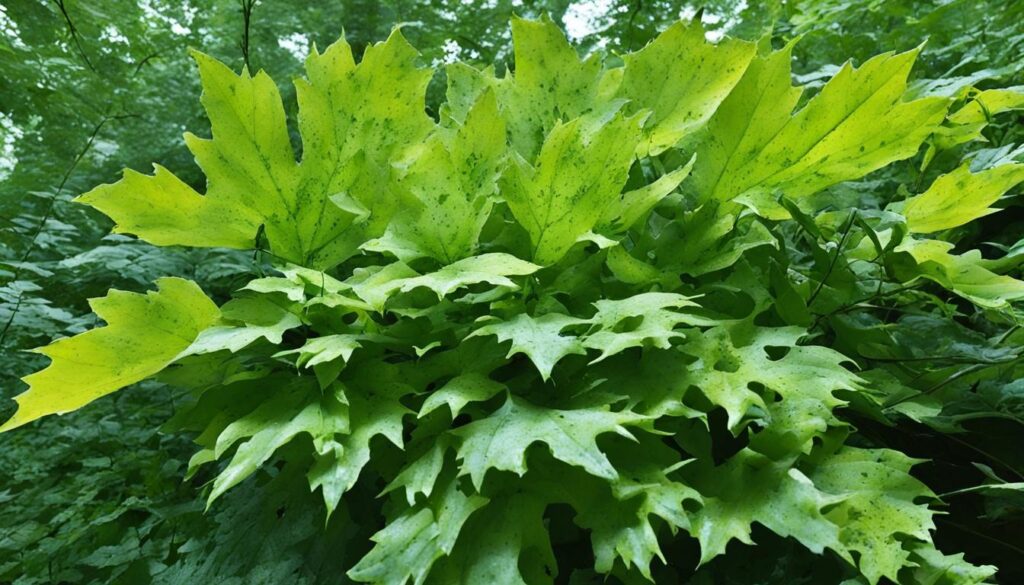
A cluster of sickly-looking leaves with dark spots and wilted edges, surrounded by a dense canopy of trees casting shadows on the vegetation. Some leaves are yellowed and curled, while others appear to be covered in a powdery mildew or fuzzy mold. Show the effects of plant diseases on shade-loving plants, with a sense of dampness and humidity in the air.
Cultural Practices for Disease Management
Site Selection and Plant Choice
Before you even plant, it’s key to pick the right spot and plants for prevention.10 If a plant looks off, it might have a disease, so you need to know plant issues. This includes the plant type, the current surroundings, and the common diseases it might get10.
Proper Planting and Maintenance
Plant issues from humans include how we plant them, like not leaving enough space for roots, wrong mulching, or cutting wrong.101 Addressing these bad practices can stop diseases. This helps the plant get back its strength and avoid future problems10.
Integrated Pest Management Strategies
Integrated pest management (IPM) looks at many ways to control pests. This includes using mechanical, cultural, biological, and chemical methods.11 Pests can be insects, mites, weeds, diseases, mammals, and birds in a garden or landscape.11 IPM was made because only using pesticides wasn’t enough to deal with pests.11
Monitoring and Scouting
An IPM plan includes watching and looking for insects to know them better. It’s about finding the right time to treat them. And seeing if those treatments worked.11 Noticing pests early and acting fast is key. It helps solve problems before they get worse.11 Checking for pests should happen often for plants, like every week for veggies and every few weeks for flowers and trees.12 Then, not as often for the same plants when they go dormant.12
Biological Control Options
Stopping pests before they appear is the best, cheapest, and greenest way. This includes preparing the soil and picking the right plants. Managing weeds and changing where you grow plants are also important.11 Making sure plants are healthy and happy makes them less likely to get sick or have pest problems.11 There are ways to use other insects to control bad ones in IPM. This includes saving natural habitats for helpful bugs and sometimes adding more of these good bugs.12
Responsible Pesticide Use
Pesticides might work fast, but they can hurt good bugs and the environment. IPM is better for nature in the long term.11 Using chemicals is just one part of IPM. Try other ways first before using pesticides.12 Knowing the life cycle of the pest is key to using chemicals well in IPM.12 Always use pesticides as the label says. Using the wrong kind or amount can cause pests to get used to the chemical.11 This makes the chemical less effective over time. Some pesticides can be bad for people, the environment, or other helpful bugs.11
Keeping good records is important in IPM. Knowing when plants were planted, when they bloomed or were harvested. Noting down when pests showed up and what was done about it helps manage the garden better.11 This information is vital for making good choices in IPM.12
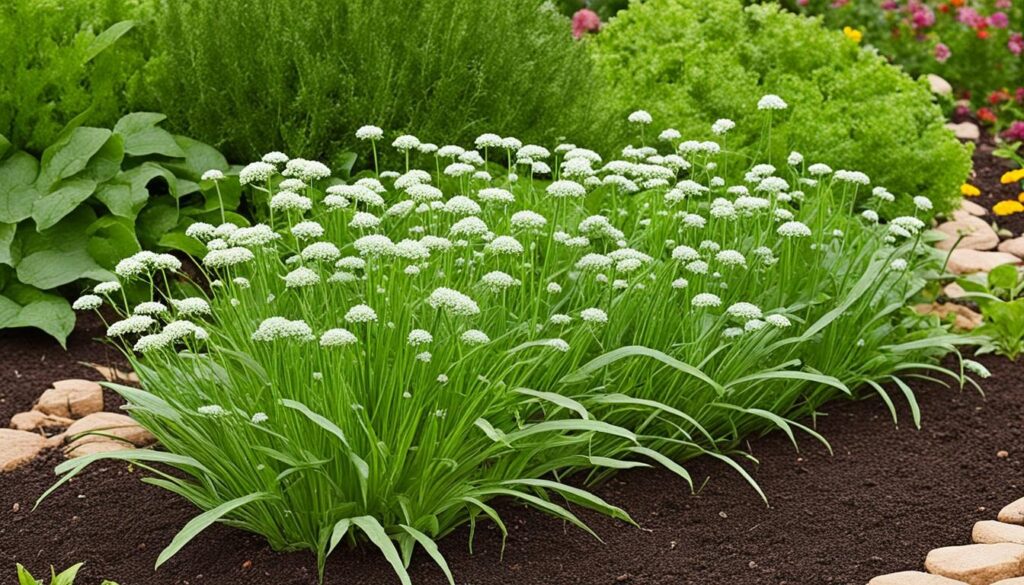
Create an image showcasing the use of organic methods to prevent and treat plant diseases in shaded areas. Incorporate natural predators of pests, such as ladybugs and praying mantises, and methods such as crop rotation and companion planting. Show how these tactics work together to create a healthy and disease-resistant garden environment.
Specific Disease Prevention and Treatment
Foliar Diseases
Many tree foliar diseases come from fungi.8 Most of these diseases make trees look bad, but don’t kill them.8 The weather plays a big role in how much disease we see, and it can be hard to stop or cure them.8 One good way to fight some of these diseases is by cleaning up fallen leaves in the autumn. Those leaves can spread infection next year.8
Stem and Root Diseases
Just like foliar diseases, the main cause of stem diseases is fungi.8 These diseases can harm the tree’s vascular system, especially the phloem. Some of them can even kill parts of the tree, or the whole tree.8 If a branch is infected, cutting it off might save the rest of the tree. But it’s hard to save a tree with a diseased trunk.8
Conclusion
This article gives a detailed look into plant diseases. It covers their cycles, how pathogens survive, and what affects plant health. We also explore how plants defend themselves and the importance of light. Understanding these topics helps gardeners and horticulturists fight diseases in shaded areas.
We dive into how to keep plants healthy, sharing methods to prevent and treat diseases. This includes tips for handling foliar, stem, and root issues. The piece also discusses how plants react to their environment, like through leaf aging and seeking light. Such insights are key for making smart choices in plant care.
Using the advice in this article, professionals and hobby gardeners alike can protect their plants. By understanding and applying these strategies, even shadowy gardens can thrive. The goal is to ensure plants remain healthy and fruitful for the long haul, despite the challenges.
FAQ
What is a plant disease and how is it defined?
A plant disease is like a plant’s sickness. It happens when a plant gets constantly bothered by something. This something is called a pathogen.
It can make the plant sick in many ways. This affects the plant’s life like how it grows or reproduces.
What is the difference between biotic and abiotic plant disorders?
Biotic problems come from living things that make plants sick. Abiotic issues come from non-living things. This includes things like bad weather or wrong soil.
Figuring out the cause is key to helping the plant. It’s important for making a plan to fix it.
What are the three conditions required for a plant disease to develop?
For a disease to happen, three things are needed. The first is a pathogen. The second is a plant that can get sick. And the third is the right environment for the disease to grow.
Preventing any of these conditions is the best way to avoid disease.
How do pathogens survive between growing seasons?
In cold weather, pathogens find ways to stay alive. They hide in plant remains or form tough structures.
Some move to new areas or wait in seeds. This is how they survive until plants grow again.
What are some common abiotic plant disorders?
Abiotic disorders are not caused by living things. They can be due to planting wrong or damaging the plant. Bad weather like drought can also harm plants.
How do plants defend against biotic and abiotic stresses?
Plants have smart ways to protect themselves. They use innate immunity and other complex defenses. These include mechanisms like making their own medicines.
They even respond to light to help their immune system. This shows how amazing plants are at surviving.
What are some challenges of growing plants in shaded environments?
Shade makes plants weaker and easier to get sick. It can also keep their leaves wet. Wet leaves can lead to diseases.
Many of these diseases are from fungi. They are tough to avoid because they are so focused on the weather.
How can plant diseases be prevented and managed?
To stop diseases, start with the right site and plants. Good care and watching for problems are crucial.
Use safe ways to fight diseases. This includes natural controls and chemicals only when really needed.
How can foliar and stem diseases be addressed?
Foliar diseases are often tackled by cleaning up. Raking away leaves stops many diseases from coming back.
For big problems in the plant’s system, sometimes cutting out the sick parts is the best fix. But, this might not always save the plant.
Source Links
- https://extension.missouri.edu/publications/mg13
- https://content.ces.ncsu.edu/extension-gardener-handbook/5-diseases-and-disorders
- https://www.apsnet.org/edcenter/disandpath/abiotic/intro/Pages/Abiotic.aspx
- https://www.ncbi.nlm.nih.gov/pmc/articles/PMC7982811/
- https://www.ncbi.nlm.nih.gov/pmc/articles/PMC8891579/
- https://www.ncbi.nlm.nih.gov/pmc/articles/PMC9958957/
- http://ri.agro.uba.ar/files/download/articulo/2014ballare.pdf
- https://uthort.tennessee.edu/wp-content/uploads/sites/228/2024/02/SP546-Diseases-of-Shade-Ornamental-Trees.pdf
- https://ipm.illinois.edu/diseases/series600/rpd621/index.html
- https://extension.unr.edu/publication.aspx?PubID=2647
- https://content.ces.ncsu.edu/extension-gardener-handbook/8-integrated-pest-management-ipm
- https://extension.arizona.edu/sites/extension.arizona.edu/files/pubs/az1521.pdf

